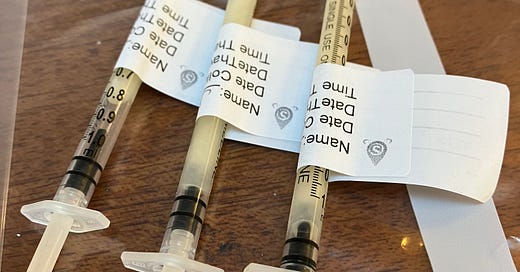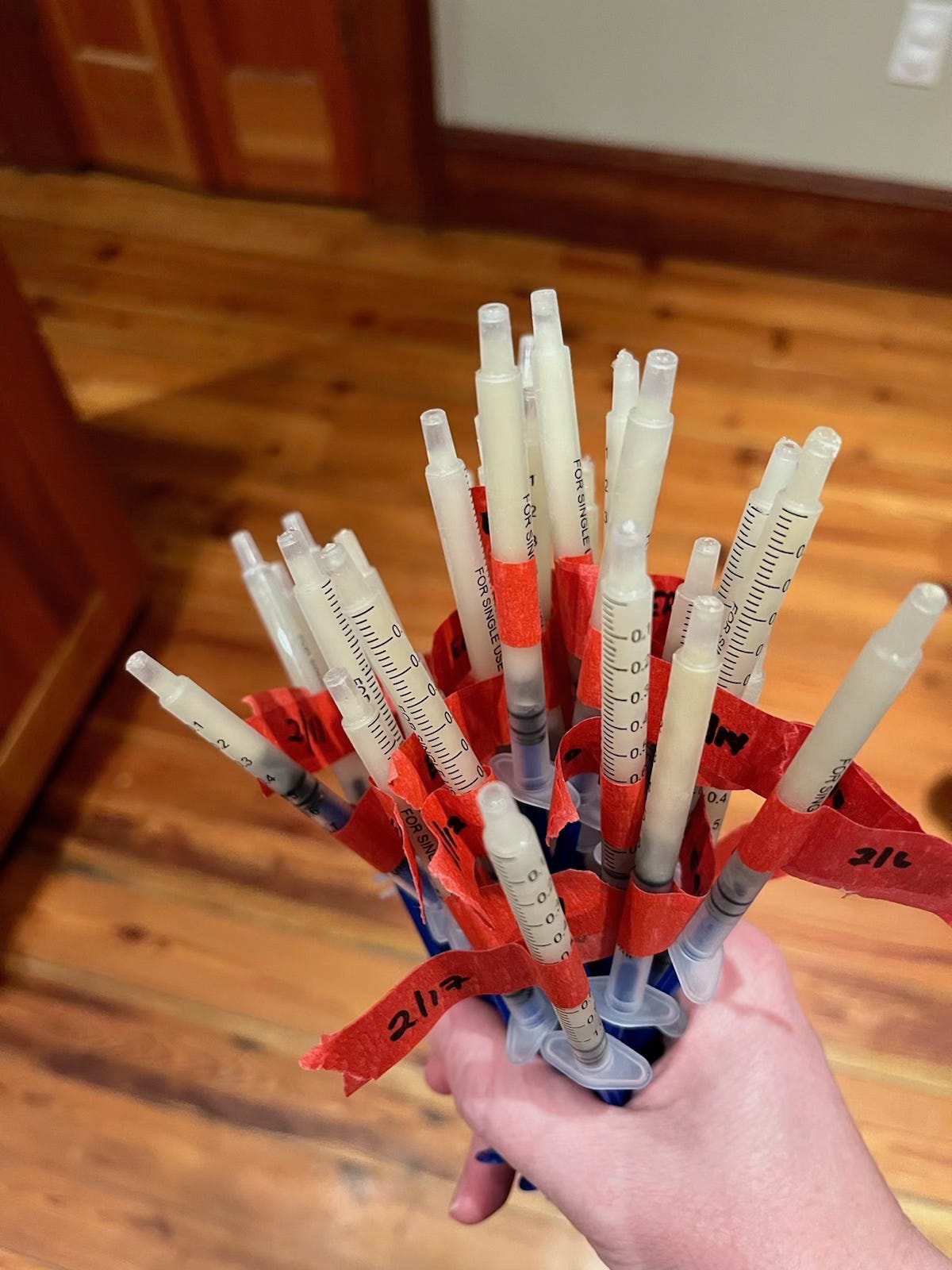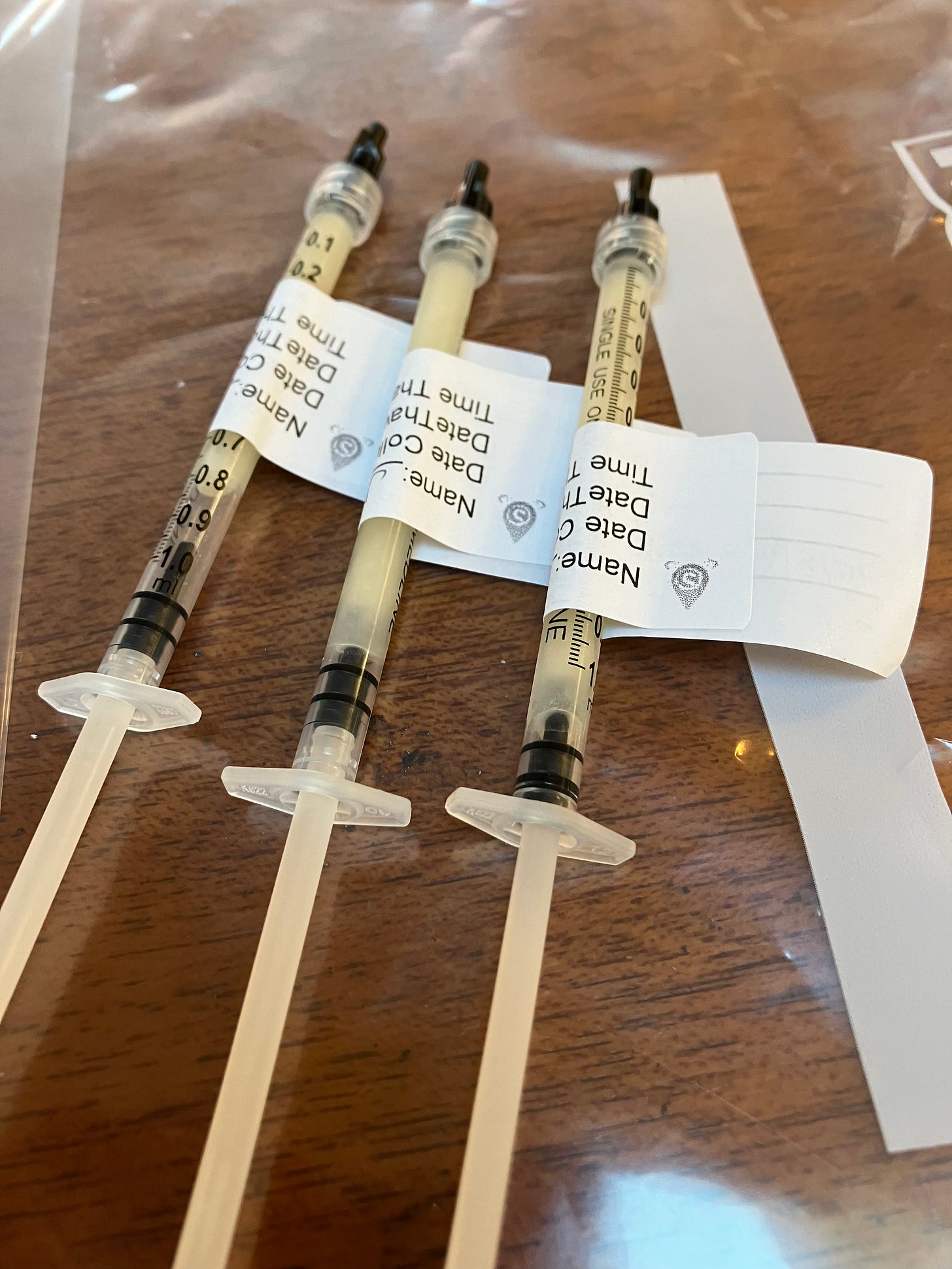This post will review antenatal milk expression (AME). We’ll look at two studies, the DAME study and a systematic review, and then discuss how AME is supposed to work. I also was able to interview a new mom who recently did AME to get her thoughts on how it went.
I find AME fascinating and see moms coming in every week with colostrum collected during their pregnancy. But it is important to remember that not every expecting mom will be able to collect colostrum - but learning the skill of hand expression is certainly valuable.
Background
Human milk production begins around the 16th week of pregnancy. Antenatal milk expression is when a woman uses hand expression to express colostrum several times a day often starting at around 36 weeks of gestation. This colostrum is saved, stored, and used after the birth of the baby. Again, it is important for expecting persons to know that they may not be able to harvest any colostrum and that is ok. Learning the technique before birth is a valuable tool to have.
The DAME study and a systematic review
The DAME Study, short for Diabetes and Antenatal Milk Expressing, was the first look at the practice of AME in a scientific way. The researchers performed a multicenter, two-group, unblinded, randomized controlled trial in six hospitals in Victoria, Australia. The study enrolled women with pre-existing or gestational diabetes. They randomized 319 women to twice daily antenatal milk expression (AME) starting at 36 weeks and 316 women to standard care (usual midwifery and obstetric care, supplemented by support from a diabetes educator). (1)
The primary outcome of the study, published in Lancet, was the proportion of infants admitted to the NICU. They also were able to assess safety and efficacy of antenatal expressing in the study subjects.
Is Antenatal Milk Expression (AME) safe? The DAME study found the answer to be YES, antenatal milk expression is safe. The study found no increased risk of obstetric or neonatal adverse outcomes in the study group.
In another study, a 2023 systemic review on the topic, a total of 1,410 studies were identified. Only two received an overall rating of strong quality and low-risk bias. Many of the studies focused on women with diabetes. The authors concluded that the literature is limited, and most studies focused on women with diabetes. “The current limited evidence suggests that antenatal breast milk expression (ABME) may be a helpful tool in improving maternal breastfeeding confidence and breastfeeding outcomes. Negative side effects reported related to ABME included difficulty learning the technique, discomfort, and feeling of awkwardness while expressing.” (2)
How do you do AME?
How exactly do you do AME, for how long do you it, and how much should people expect to get?
Use the same technique as postnatal hand expression.
For the DAME study, the women did AME twice a day, no more than 10 minutes each time, starting at 36 weeks
Women should not expect large volumes --- you may see nothing and that is ok.
What do you put the colostrum in? Do you freeze it?
Many women will hand express into a spoon or container (a shot glass works), draw the colostrum into a syringe, cap it, label it, and freeze it.
Use the same storage guidelines as used for post-partum milk supply.
Where to buy kits
My daughter liked the antenatal milk expression kits we got from Sweet Sips. The kit came with syringes, caps, collection cups and labels. The owner of the company is my friend and lactation colleague, Mary Foley. Link to Sweet Sips
Personal story
I asked a new mom, SJS, “What did you think of AME?” She is 33 years old and this was her first pregnancy.
Q. Tell me about how you started the process.
A. “At 36 weeks I wanted to see if I had any milk in there. One day, after a shower, I squeezed my boob and a little drop came out. I didn’t want him to come to early so I didn’t get going until 37 weeks. Then, once a day - after a shower – I would do it. After three weeks (by the time he was born) I had almost 10 cc total. I would collect it with a spoon and suck it up with a syringe, cap it, label it with the date and time, and put it in freezer.”
Q. Do you have any other thoughts or tips to share?
A. Her comments are below.
“You have to work at it.”
“He had to go to the NICU for the first day. They had donor milk at the hospital but it was cool that he got my own milk.”
“He never got formula which was my goal.”
“I wonder if doing this is why I have such a good milk supply.”
“I would definitely do it again.”
References
Forster DA, Moorhead AM, Jacobs SE, et al. Advising women with diabetes in pregnancy to express breastmilk in late pregnancy (Diabetes and Antenatal Milk Expressing [DAME]):A multicentre, unblinded, randomised controlled trial. Lancet. 2017 Jun 3;389(10085):2204-2213.
Sobik S, Crimmins M, Hand M, et al. Education and experiences of Antenatal Breast Milk Expression: A Systematic Review. Breastfeeding Med 2023 Feb;18(2):107-115. doi: 10.1089/bfm.2022.0225. Epub 2023 Feb 1.
Tema #5. Colostrum Part 4: La Extracción de Leche Prenatal
En esta publicación adicional quiero compartir información sobre la extracción de leche prenatal. Específicamente el Estudio DAME y cómo funciona todo esto. Me parece fascinante y veo a las mamás venir todas las semanas con el calostro recolectado durante el embarazo. Es importante recordar que no todas las mujeres embarazadas podrán recolectar calostro, pero aprender la habilidad de expresarse con las manos es ciertamente valioso.
Fondo
La producción de leche humana comienza alrededor de la semana 16 de embarazo. La extracción de leche prenatal se produce cuando una mujer utiliza la extracción manual para extraer el calostro varias veces al día, a menudo a partir de las 36 semanas de gestación. Este calostro se guarda, almacena y utiliza después del nacimiento del bebé. Nuevamente, es importante que las personas embarazadas sepan que es posible que no puedan recolectar calostro y que eso está bien. Aprender la técnica antes del nacimiento es una herramienta valiosa.
El estudio DAME y una revisión sistemática
El Estudio DAME, abreviatura de Diabetes y Extracción de Leche Antenatal, fue la primera mirada a la práctica de AME de manera científica. Los investigadores realizaron un ensayo controlado aleatorio, multicéntrico, de dos grupos, no ciego, en seis hospitales de Victoria, Australia. El estudio inscribió a mujeres con diabetes preexistente o gestacional. Asignaron al azar a 319 mujeres a la extracción de leche prenatal (AME) dos veces al día a partir de las 36 semanas y a 316 mujeres a la atención estándar (partería habitual y atención obstétrica, complementada con el apoyo de un educador en diabetes). (1)
El resultado primario del estudio, publicado en Lancet, fue la proporción de bebés admitidos en la UCIN. También pudieron evaluar la seguridad y eficacia de la expresión prenatal en los sujetos del estudio.
¿Es segura la extracción de leche prenatal (AME)? Descubrieron que la respuesta es SÍ, la extracción de leche prenatal es segura. El estudio no encontró un mayor riesgo de resultados adversos obstétricos o neonatales en el grupo de estudio.
En otro estudio, una revisión sistémica de 2023 sobre el tema, se identificaron un total de 1.410 estudios. Sólo dos recibieron una calificación general de alta calidad y sesgo de bajo riesgo. Muchos de los estudios se centraron en mujeres con diabetes. Los autores concluyeron que la literatura es limitada y la mayoría de los estudios se centraron en mujeres con diabetes. “La evidencia limitada actual sugiere que la extracción prenatal de leche materna (ABME) puede ser una herramienta útil para mejorar la confianza materna en la lactancia materna y los resultados de la lactancia materna. Los efectos secundarios negativos informados relacionados con ABME incluyeron dificultad para aprender la técnica, incomodidad y sensación de incomodidad al expresarse”. (2)
¿Cómo se hace expresión prenatal de leche?
¿Cómo se realiza exactamente la extracción manual de calostro (AME), durante cuánto tiempo se realiza y qué cantidad se debe esperar obtener?
Utilice la misma técnica que la extracción manual posparto.
En el estudio DAME, las mujeres se extrajeron AME dos veces al día, no más de 10 minutos cada vez, a partir de la semana 36.
Las mujeres no deben esperar grandes cantidades; es posible que no vean nada, pero eso no es problema.
¿En qué se coloca el calostro? ¿Se congela?
Muchas mujeres extraen calostro manualmente en una cuchara o recipiente (un vaso de chupito funciona), lo extraen con una jeringa, lo tapan, lo etiquetan y lo congelan.
Utilice las mismas pautas de almacenamiento que para la producción de leche posparto.
Dónde comprar kits
A mi hija le encantaron los kits de extracción de leche prenatal que compramos en Sweet Sips. El kit incluía jeringas, tapas, vasos recolectores y etiquetas. La dueña de la empresa es mi amiga y compañera de lactancia, Mary Foley. Link to Sweet Sips
Historia personal
Le pregunté a una nueva mamá, SJS, “¿Qué te pareció of expresión prenatal de leche ?” Tiene 33 años, este es su primer embarazo.
P. Cuénteme cómo inició el proceso.
R. “A las 36 semanas quería ver si tenía leche. Un día, después de la ducha, me apreté la teta y salió una gotita. No quería que llegara demasiado temprano, así que no comencé hasta las 37 semanas. Luego, una vez al día, después de la ducha, lo hacía. Después de tres semanas (cuando nació) tenía casi 10 cc en total. Lo recogía con una cuchara y lo aspiraba con una jeringa, lo tapaba, lo etiquetaba con la fecha y la hora y lo metía en el congelador”.
P. ¿Cómo te fue en el hospital?
R. “El personal lo sabía, pero parecía que no habían experimentado que una madre tomara tanto calostro. Pero me apoyaron mucho”.
P. ¿Alguna otra idea para compartir?
R. Sus otros comentarios están a continuación.
“Tienes que trabajar en ello”.
“Tuvo que ir a la unidad de cuidado intensivo neonatal el primer día. Tenían leche de donante en el hospital, pero fue genial que él obtuviera mi propia leche”.
"En el hospital, nunca recibió fórmula, que era mi objetivo".
"Me pregunto si es por eso que tengo tan buena producción de leche".
"Podria definitivamente hacer eso de nuevo."
Referencias
Forster DA, Moorhead AM, Jacobs SE, et al. Aconsejar a las mujeres con diabetes durante el embarazo que se extraigan la leche materna al final del embarazo (Diabetes and Antenatal Milk Expressing [DAME]): un ensayo controlado aleatorio, multicéntrico y no ciego. Lanceta. 3 de junio de 2017; 389 (10085): 2204-2213.
Sobik S, Crimmins M, Hand M, et al. Educación y experiencias sobre la extracción de leche materna prenatal: una revisión sistemática. Breastfeeding Med 2023 febrero;18(2):107-115. doi: 10.1089/bfm.2022.0225. Publicación electrónica del 1 de febrero de 2023.








Thanks for the shout out to “Sweet Sips!”